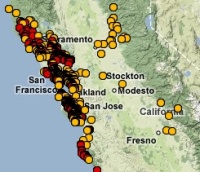Holiday collection: fun sites from the end of 2008 (and Maya Lin at the De Young!)
/So many site, so little space. So here's my wrap-up from G.reader on the cool stuff floating around at the end of the year (Many from the Map Room blog, a wonderful font of mapping information).
- Boston Globe's Year in Maps article. This has some lovely examples of new cartography. Maybe Tim can start one of these at the Chicago Trib next year!
- NASA's gorgeous and simple Global Fire Map. I like the simplicity and effectiveness of these maps.
- Sean Gordon's wrap up of user-created maps online is an interesting read.
- Kind of gross yet cool: Mapping Rats in NY.
And last, but by no means least, if you are lucky enough to live in the bay area, and have an interest in maps/mapping/representations of landscapes, go to Maya Lin's exhibit "Systematic Landscapes" at the De Young. It is mesmerizing, fascinating, charming and thought-provoking at the same time. I just loved it. It is on through the 18th, so get on it!!!!

 Eric Sanderson is visiting CNR next week: Chris G pointed me to his work. Imagining Manhattan before European contact through visualization. Gorgeous work, and appealing on many levels for geographers everywhere.
Eric Sanderson is visiting CNR next week: Chris G pointed me to his work. Imagining Manhattan before European contact through visualization. Gorgeous work, and appealing on many levels for geographers everywhere.